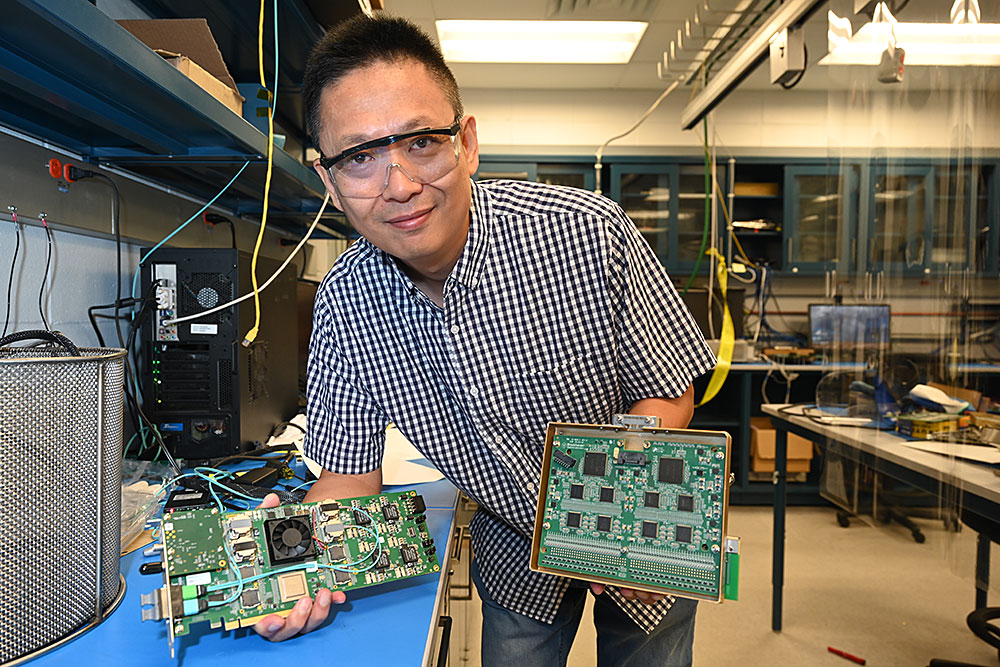Brookhaven Lab's Hucheng Chen Named a Battelle 'Inventor of the Year'
Honored for designing particle detector electronics that can read out signals under super cold conditions
August 15, 2023
 enlarge
enlarge
Brookhaven Lab's Hucheng Chen, named a Battelle "Inventor of the Year," shows two electronics boards he designed for particle detectors. The Front-End LInk eXchange (FELIX), shown on the left, is a readout electronics board for the ATLAS, ProtoDUNE-SP, and sPHENIX experiments. On the right is the Front-End MotherBoard (FEMB), which operates at cryogenic temperatures for DUNE.
Hucheng Chen, a senior physicist who designs state-of-the-art readout electronics systems at the U.S. Department of Energy’s (DOE) Brookhaven National Laboratory, was honored as an “Inventor of the Year” by Battelle, a global science and technology organization. Battelle manages Brookhaven Lab in partnership with Stony Brook University through Brookhaven Science Associates (BSA). Scientists awarded “Inventor of the Year” are recognized for their scientific or engineering contributions with societal or financial impact.
Chen is being recognized “for his original and extensive contributions to the High Energy Physics program and major innovations contributing to system optimization for integrated detectors readout.”
“I'm deeply honored to receive this recognition, which wouldn't be possible without the excellent work done by my talented colleagues in the Physics Department and the Instrumentation Division,” Chen said. “I am so grateful to the leaders in the Physics Department for their continuous support, and to my mentor, Veljko Radeka, from Instrumentation, for his guidance.”
Chen’s expertise lies in designing readout systems and front-end electronics for complex particle detectors used in high energy physics experiments. These particle detectors generate tens of terabytes of data every second—the equivalent of snapping and storing 15,000,000 photos per second. Chen’s electronics convert the signals generated by the detectors into data physicists can analyze to make discoveries.
These electronics often must work under extreme conditions involving high radiation or super cold temperatures. For example, massive detectors designed to detect ghostlike neutrinos—subatomic particles that may hold answers to some of the most interesting questions in physics—have chambers filled with tons of cold liquid, like argon, at -303 degrees Fahrenheit. Neutrinos move throughout the chamber and occasionally interact with the argon atoms. These interactions leave behind traces of electrons that scientists study to learn about neutrinos. Chen has spent many years developing electronics that can withstand the cold temperatures without compromising their ability to sense and amplify the signals generated by the electron traces.
“Many challenges come with designing electronics that work in extreme environments,” Chen explained. “There are no readily available solutions from industries, and special R&D studies are required to address these obstacles. Over the past decade we have developed the design rules, used cryogenic models, and realized stringent test programs following the integral system design concept. This all ensures the long-term reliability of devices, which need to last for the entire lifetime of the experiment, often 20 to 30 years.”
Chen has developed “cold microelectronics” for neutrino detectors globally, including MicroBooNE at Fermi National Accelerator Laboratory (FNAL), ProtoDUNE-SP at Europe’s CERN laboratory, the Short-Baseline Near Detector (SBND) at FNAL, and the Deep Underground Neutrino Experiment (DUNE) at the Sanford Underground Research Facility in South Dakota. He’s also led and co-led teams that developed electronics for the ATLAS experiment at CERN’s Large Hadron Collider.
Experiments and facilities at Brookhaven Lab—including the sPHENIX detector at the Relativistic Heavy Ion Collider (RHIC) and the National Synchrotron Light Source II (NSLS-II)—have benefitted from Chen’s technology expertise and solutions, as well.
These state-of-the-art electronics enable more precise measurements of the particles that make up the Standard Model of particle physics, contributing to our understanding of the underlying structure of our universe.
Chen’s “Inventor of the Year” Award was announced as part of Battelle’s annual “Celebration of Solvers” in Columbus, Ohio, on May 11.
Chen earned a bachelor’s degree in nuclear electronics in 1995 and a Ph.D. in particle and nuclear physics in 2000, both from the University of Science and Technology of China. He joined Brookhaven Lab as a postdoctoral research associate in 2000 and after moving up the ranks is now a senior physicist. He holds two patents on readout electronics. Chen was a 2013 recipient of a Brookhaven Science and Engineering Award—one of Brookhaven Lab’s highest honors.
Chen’s work is supported by the DOE Office of Science (HEP). RHIC and NSLS-II are DOE Office of Science user facilities.
Brookhaven National Laboratory is supported by the Office of Science of the U.S. Department of Energy. The Office of Science is the single largest supporter of basic research in the physical sciences in the United States and is working to address some of the most pressing challenges of our time. For more information, visit science.energy.gov.
Follow @BrookhavenLab on social media. Find us on Instagram, LinkedIn, Twitter, and Facebook.
2023-21373 | INT/EXT | Newsroom









